
A l'origine, nef unique recouverte d'un berceau en bois, remplacé en suite par du plâtre. La croisée du transept est occupée par une coupole sur trompes qui porte le clocher, contrebutée par des quarts de cercle. Sur les croisillons, absidioles en cul de four. Au 17e siècle, une chapelle a remplacé le bras du transept. Chapiteaux sculptés.
LES DIFFERENTS CALCAIRES
CALCAIRE OOLITHIQUE

De toucher rugueux et d'aspect granuleux, il est composé de grains calcaires (= oolithes) cimentés dans une matrice elle-même calcaire (ce que l'on peut vérifier en réalisant un test à obtenir). Les oolithes sont des figures de précipitation de forme circulaire, des concrétions carbonatées concentriques formées autour d'un noyau (grain quelconque, fragment de coquille ...)
Ce calcaire oolithique est caractéristique d'un milieu de sédimentation de type plaque-forme carbonatée. Les oolithes (granulations observées) se forment par précipitation chimique en milieu marin très peu profond (1 à 10 m) et suffisamment agité pour soulever régulièrement les oolithes en formation (eau à la limite de la saturation en carbonates dissous), on observe actuellement leur formation à proximité de zones récifale (application du principe d'actualisme).
Pour la construction, ce calcaire atteint des qualités de dureté et de résistance au gel (peu de fractures observées). Il est à noter qu'on ne trouve pas cette roche dans le log (colonne stratigraphique) et qu'elle ne correspond pas aux roches observées dans le sous-sol.
CALCAIRE MICRITIQUE OU LITHOGRAPHIQUE
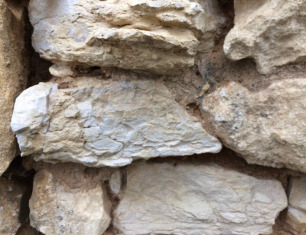
Calcaire beige, de toucher plus lisse et dont la cassure est conchoïdale par endroit. Ce sont également des calcaires de plaque-forme carbonatée mais ils se forment par précipitation dans un milieu de sédimentation plus calme.
Le caractère lithographique de la roche peut arriver à s'interroger sur une autre utilisation possible de ce type de roches. En effet, ces calcaires sont suffisamment durs pour servir à la construction mais en raison de la finesse de leur grain, ils peuvent également être utilisés pour la gravure (d'où la désignation «lithographique»).
RÉSOLUTION
Identifiez les zones de recherche des question a partir de la photo ci-dessous.
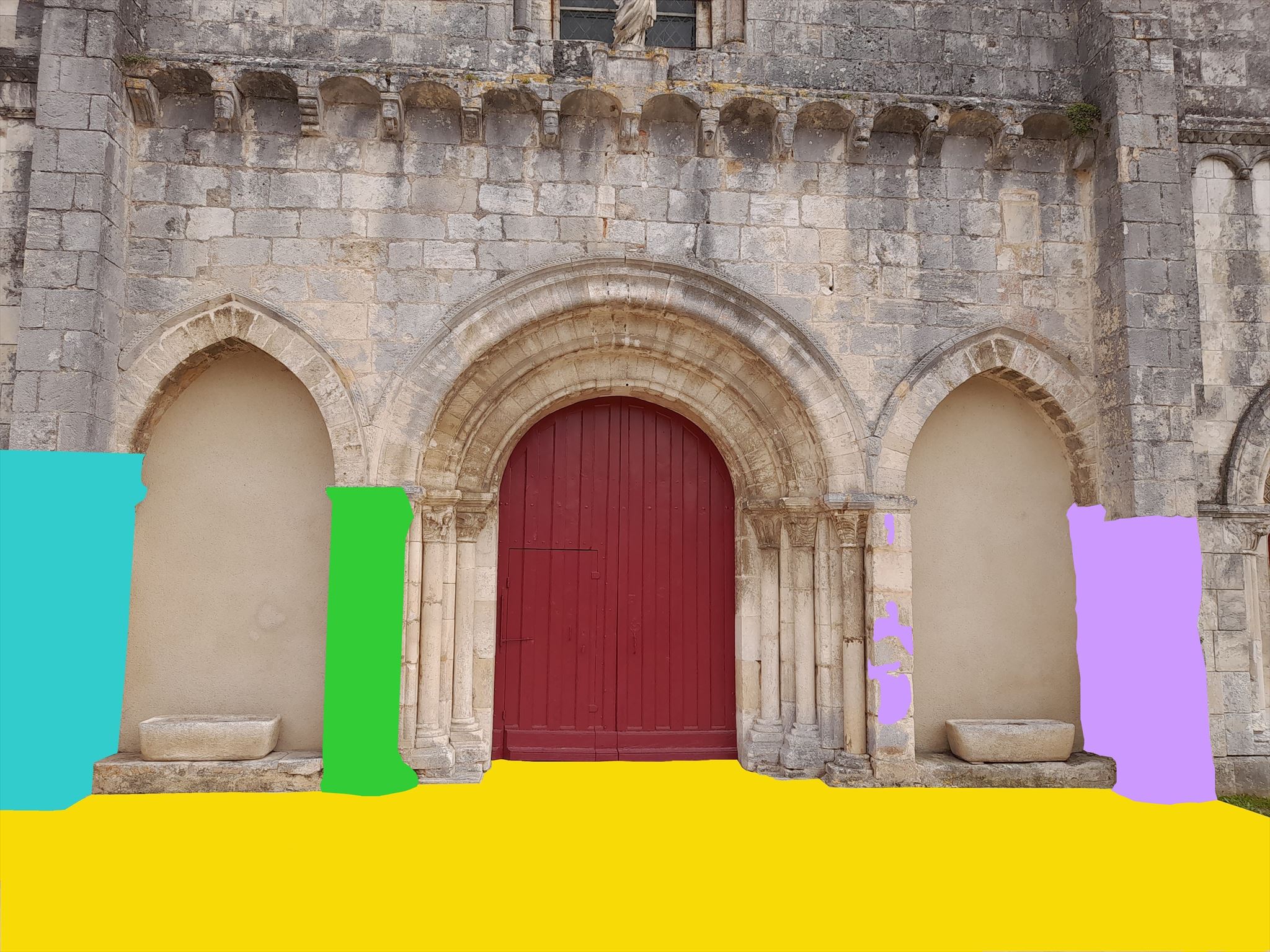
Partie 1 - Jaune
Analysez le sol du parvis de l'église. De grandes dalles de calcaire sont présentes et recouvrent entièrement le pont.
Question 1: Les traces sont horizontales ? verticales ? en diagonale ? ou d'une autre "forme"
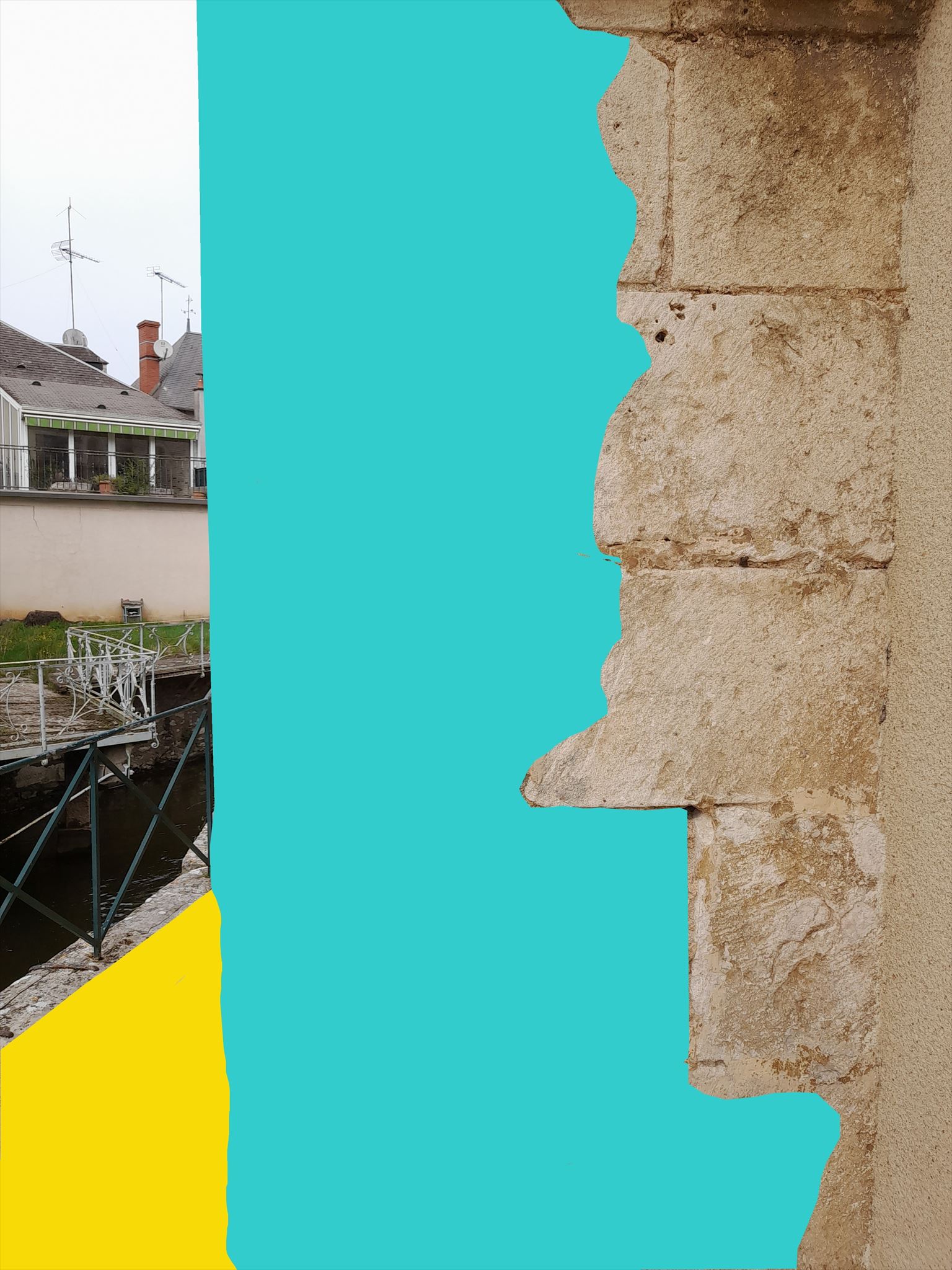
Regardez sur la paroi intérieure gauche de la partie bleue et répondez à la question suivante :
Question 2: Ici le calcaire par rapport à la majorité de la surface est de quelle couleur ? Est-ce normal pour du calcaire ?
Partie 3 - Verte

Retournez-vous, toujours dans l'intérieur, répondez à la question suivante :
Question 3: Les laminations sont horizontales? Verticales? En diagonale?
Partie 4 - Violet
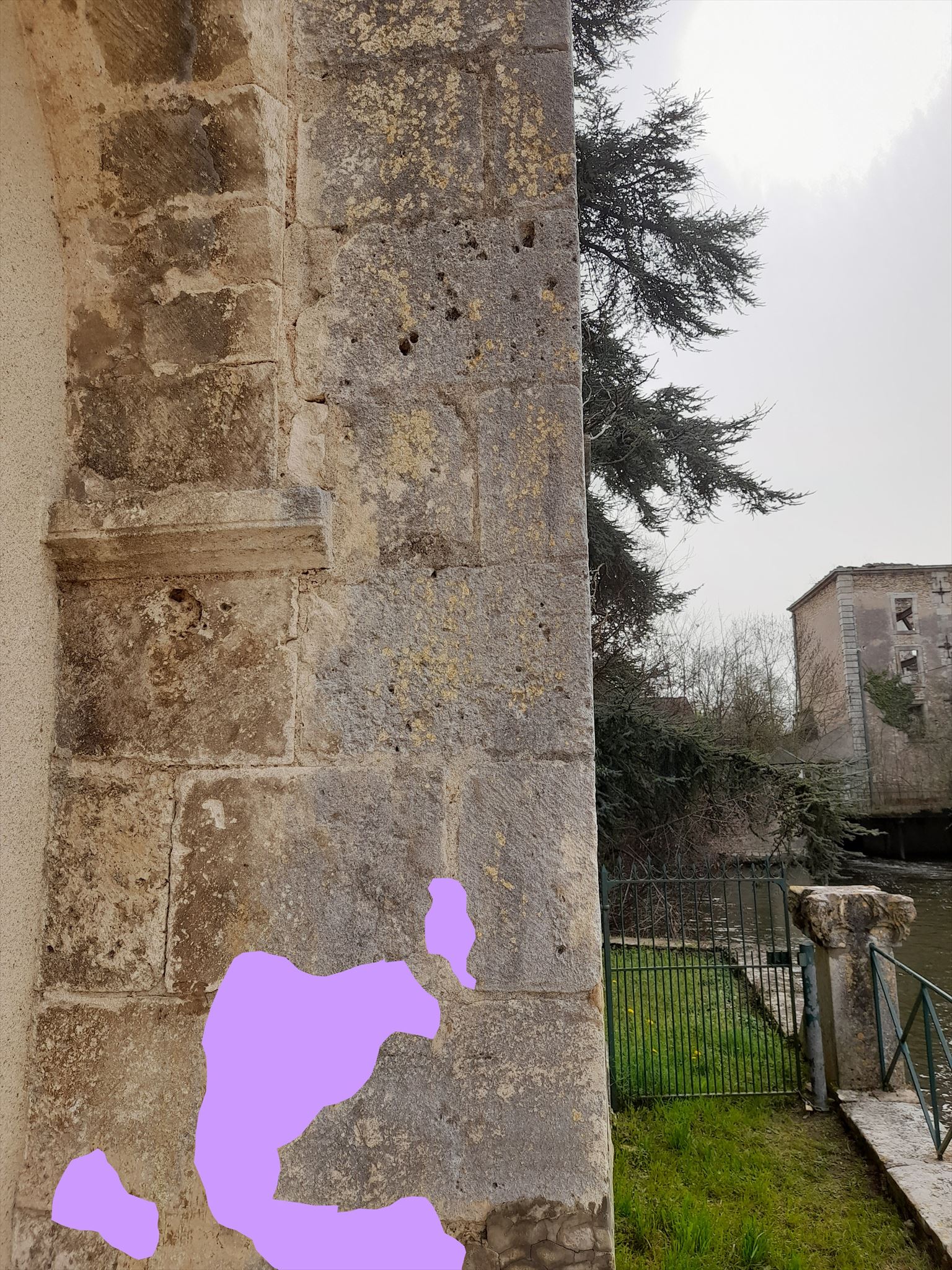
Rendez-vous de l'autre côté de la porte dans la zone sur la photo ou voir sur la photo générale.
Question 4 : Ici le calcaire par rapport à la majorité de la surface est de quelle couleur ? A quoi peut être due cette couleur ?
Question générale
A l'aide du texte au-dessus, carré bleu identifiez le calcaire présent ici.
Rappel concernant les « EarthCaches » : Il n’y a pas de conteneur à chercher. Il suffit de se rendre sur les différents lieux, de répondre aux questions ci-dessous et de me les envoyer via la messagerie Géocaching.
Vous pouvez loguer sans attendre ma confirmation, tout en m’envoyant en même temps vos réponses. Les logs sans réponses seront automatiquement supprimés.
Une photo de vous ou de votre GPS avec le lieu en arrière-plan sera obligatoire, conforme aux nouvelles Guidelines.
Loguez cette cache «Trouvé» et envoyez-moi vos réponses via mon profil ou la messagerie géocaching.com (Message Center). J'analyserais vos réponses et vous contacterais en cas de problème.

Originally, single nave covered with a wooden cradle, later replaced by plaster. The transept frame is occupied by a cupola on trunks that carries the bell tower, counterbalanced by quarters of a circle. On the lattices, apsidioles in the bottom of the oven. In the 17th century, a chapel replaced the arm of the transept. Capitals sculpted.
THE DIFFERENT TYPES OF LIMESTONE
Oolitic limestone

Rough to the touch and grainy in appearance, it is composed of limestone grains (= oolites) cemented in a matrix which is itself limestone (which can be verified by carrying out an acid test). Oolites are circular precipitation figures, concentric carbonate concretions formed around a nucleus (any grain, shell fragment, etc.)
This oolitic limestone is characteristic of a carbonate platform type sedimentation environment. The oolites (observed granulations) are formed by chemical precipitation in a very shallow marine environment (1 to 10 m) and sufficiently stirred to regularly lift the oolites in formation (water at the limit of saturation in dissolved carbonates), their current is observed. training near reef areas (application of the actualism principle).
For construction, this limestone combines qualities of hardness and resistance to frost (few fractures observed). It should be noted that this rock is not found in the log (stratigraphic column) and that it does not correspond to the rocks observed in the subsoil.
Micritic or lithographic limestone

Beige limestone, smoother to the touch and with a conchoidal break in places. They are also carbonate platform limestones, but they form by precipitation in a calmer sedimentation environment.
The lithographic character of the rock may raise questions about another possible use for this type of rock. Indeed these limestones are hard enough to be used for construction but due to the fineness of their grain, they can also be used for engraving (hence the designation "lithographic").
RESOLUTION
Identify the question search boxes from the photo below.
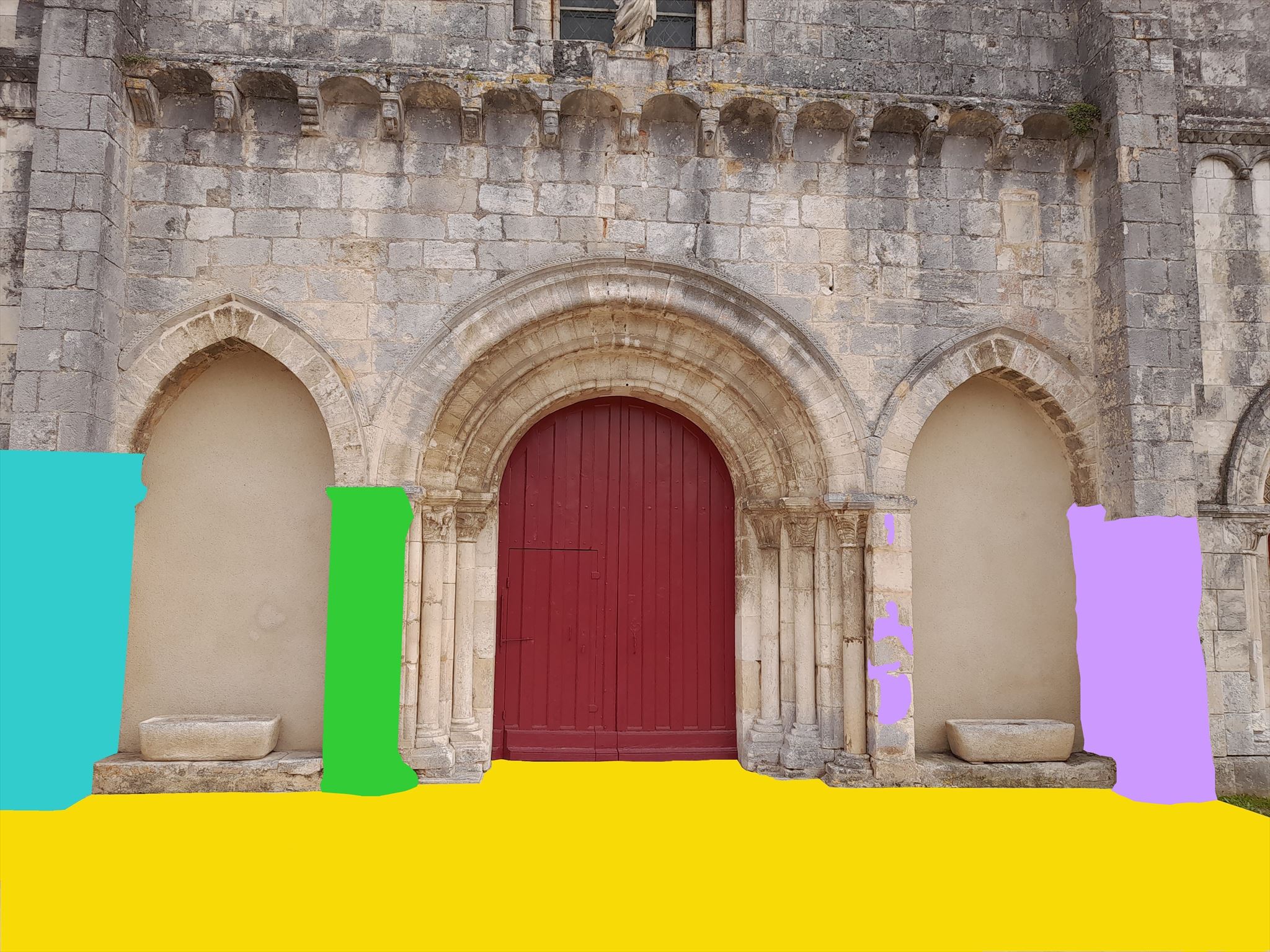
Part 1 - Yellow
Analyze the floor of the church square. Large limestone slabs are present and completely cover the bridge.
Question 1: The traces are horizontal? vertical? diagonal? or of another "shape"

Look at the left inner wall of the blue part and answer the following question:
Question 2: Here the limestone in relation to the majority of the surface is of what color? Is this normal for limestone?
Part 3 - Green

Turn around, always inside, answer the following question:
Question 3: Are the laminations horizontal? Vertical? Diagonal?
Part 4 - Purple

Go to the other side of the door in the area on the photo or see on the general photo.
Question 4 : Here the limestone in relation to the majority of the surface is of what color? To what can be due this color?
General question
Using the text above, blue square identify the limestone present here.
Reminder about the "EarthCaches": There is no container to search. You just have to go to the different places, answer the questions below and send them to me via the Geocaching messenger.
You can log without waiting for my confirmation, while sending me your answers at the same time. The logs without answers will be automatically deleted.
A picture of you or your GPS with the place in the background will be mandatory, according to the new Guidelines.
Log this cache "Found" and send me your answers via my profile or the geocaching.com message center. I will analyze your answers and contact you if there are any problems.